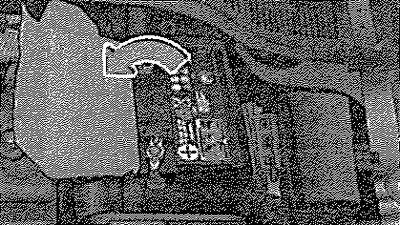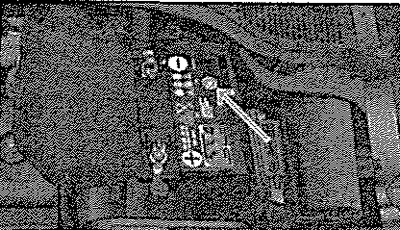Engine compartment: polyester battery cover

The battery is located in the engine compartment, in some trim levels it is located under a polyester cover. Open the battery cover in the direction of the arrow. Installing the battery cover is carried out in reverse order. The edge of the polyester cover is inserted between the battery and the side wall of the battery casing during work on the battery.
Battery: electrolyte level indication

In a battery with a color indicator, the so-called «magic eye», the electrolyte level can be determined by the color of the indicator. The color of the indicator may be affected by the presence of air bubbles. Therefore, before checking, carefully tap on the indicator. Black indicator - electrolyte level is normal. Colorless or light yellow - the electrolyte level is too low, the battery needs to be replaced. Vehicles with a start-stop system are equipped with a battery control unit that monitors the charge level to restart the engine. It is recommended to regularly check the electrolyte level at the workshop, especially in the following situations: high outside temperature, long daily trips, after each charge.
Winter operation
At low temperatures, the starting power of the battery is noticeably reduced. A discharged battery can freeze even at temperatures slightly below 0°C. Before the start of the winter period, it is recommended to check the battery at a service station and, if necessary, charge it.
Carefully! For technical reasons, it is not possible to check the electrolyte level in batteries marked «AGM». The electrolyte level in the battery is also checked regularly as part of the inspection service at the service station.
Charger
For the normal course of the process of starting the engine, the contamination of the battery is extremely important. Switch off the ignition and all electrical consumers. Only when «fast charging»: Disconnect both connecting cables from the battery terminals (at first «minus», then «plus»). Install the charger clamps on the battery poles (red = «plus», black = «minus»). Connect the charger to the mains and turn it on. After charging is completed: switch off the charger and unplug the mains cable from the socket. Now disconnect the charger terminals first. If necessary, reconnect the connecting cables to the battery terminals (at first «plus», then «minus»). When charging with low current (e.g. when using a portable charger) connecting cables can not be disconnected. Follow the charger manufacturer's instructions. Until the battery is fully charged, the charge current should remain at the level of 0.1 of the battery capacity (or below). Before charging with a high current, the so-called «fast charging», both connecting cables must be disconnected from the battery terminals. During charging, do not open the battery caps.
Attention! «Rapid charging of a car battery is dangerous, it requires a special charger and professional knowledge. On vehicles with start-stop system, the terminal clamp of the charger must not be connected directly to (-) battery pole, but only to the engine ground.
Battery replacement
When replacing the battery, the new battery must have the same capacity, voltage, current and the same dimensions. A battery of a suitable type can be purchased at a service station. It is recommended to replace the battery at a service station.
Disconnection and connection
After disconnecting and reconnecting the batteries, the following functions remain switched off for some time or work with errors: (violations at work), head unit or head unit with navigation system - enter the code, set the time, the multifunction display data is deleted.
Automatic shutdown of consumers
The onboard power supply control unit automatically takes measures to prevent battery discharge when the battery is heavily loaded. This may be indicated by the following: idle speed increases (to increase the current supplied by the generator to the on-board network); In some cases, the output of large consumers of comfort systems, such as seat heating, heated rear window, may be limited or, if necessary, they may be switched off completely.
Carefully! In some cases, the onboard power supply management system cannot prevent battery discharge. For example, if the ignition is turned on for a long time with the engine turned off or the side/parking lights are on during a long period of parking. Consumers powered by a 12 V socket with the ignition off can lead to battery discharge. The possible automatic shutdown of consumers does not lead to a decrease in the comfort of the trip and, as a rule, the driver does not notice it at all.
